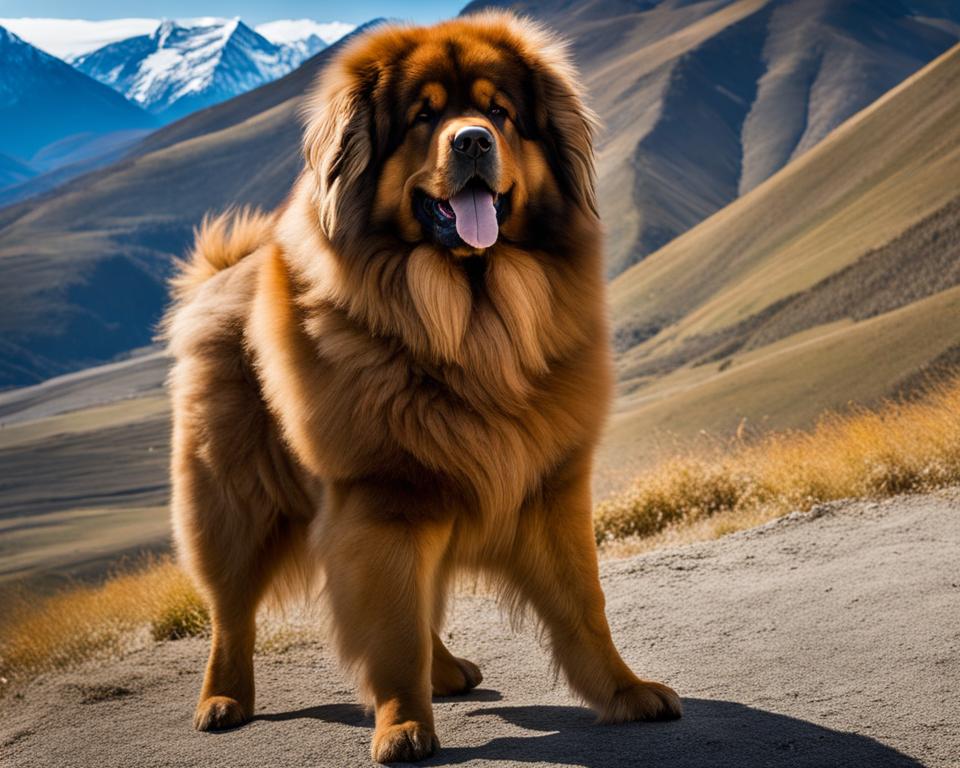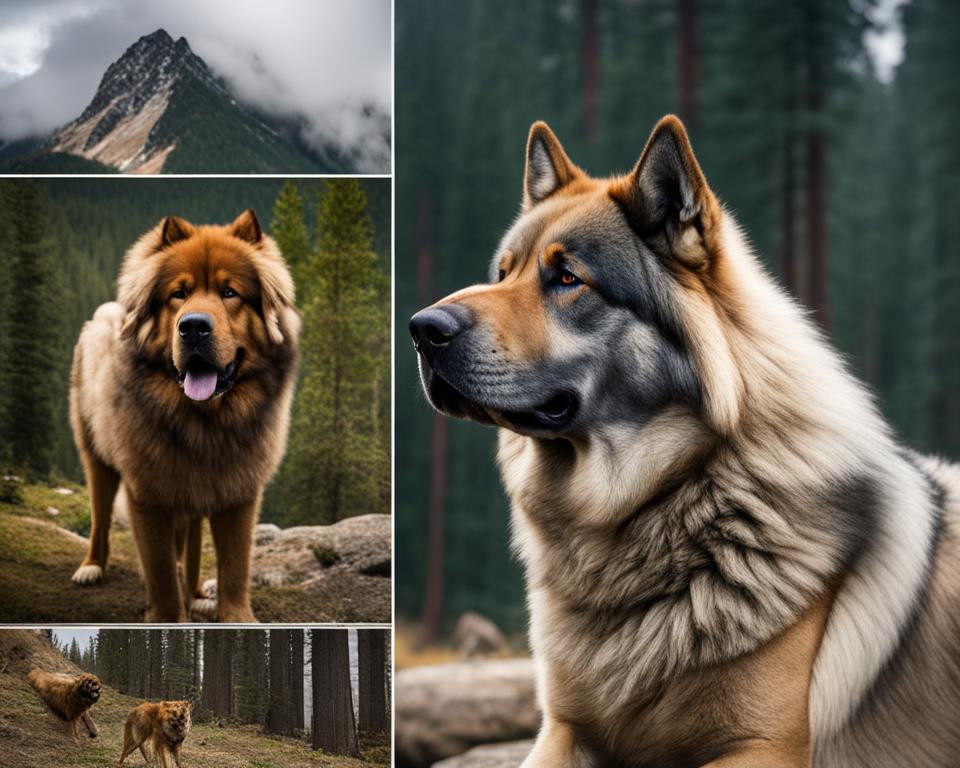The Tibetan Mastiff and the wolf are two fascinating creatures that share a connection rooted in the harsh landscapes of Tibet and the Himalayas. While their physical characteristics may have similarities, there are distinct differences that set them apart. In this article, we will explore the variations between these two magnificent beings and gain a deeper understanding of their unique qualities.
Key Takeaways:
- The Tibetan Mastiff is an ancient and rare breed of dog found in Tibet and the Himalayas.
- Tibetan Mastiffs are known for their impressive size and strong build, weighing up to 150 pounds.
- Wolves, although smaller in size compared to Tibetan Mastiffs, have adapted to survive in the wild as predatory animals.
- Tibetan Mastiffs have a varied omnivorous diet, while wolves primarily consume prey animals.
- Tibetan Mastiffs have genetic similarities to wolves, specifically the EPAS1 gene, which helps them thrive at high altitudes.
Size Differences
The size of a Tibetan Mastiff and a wolf can vary significantly, with each species possessing distinct characteristics and physical attributes.
Tibetan Mastiffs are renowned for their impressive size, making them one of the largest dog breeds in existence. These magnificent creatures can reach weights of up to 150 pounds, with some individuals even surpassing this mark. Their stature and strong build contribute to their intimidating presence and commanding appearance.
On the other hand, wolves, while still formidable, tend to be smaller in comparison to Tibetan Mastiffs. The size of a wolf can differ depending on the species, but generally, they weigh between 50 and 100 pounds. Despite being smaller than their Mastiff counterparts, they possess agility and athleticism that aids them in their natural habitat.
Size Comparison
To further illustrate the difference in size, here is a comparison between the average measurements of Tibetan Mastiffs and wolves:
| Tibetan Mastiff | Wolf |
|---|---|
| Weight: Up to 150 pounds | Weight: Between 50 and 100 pounds |
| Height: 24 to 26 inches | Height: 26 to 32 inches |
| Length: 25 to 28 inches | Length: 36 to 63 inches |
As evident from the comparison, Tibetan Mastiffs have a more substantial weight and height, while wolves have a longer body length. These distinctions in size contribute to the remarkable diversity between the two species.
Behavior Differences
When it comes to behavior, Tibetan Mastiffs and wolves exhibit distinct characteristics rooted in their respective evolutionary backgrounds.
Tibetan Mastiffs are renowned for their loyal and protective nature. They make excellent guard dogs, displaying unwavering devotion to their families. However, their loyalty can lead to aggression towards strangers if they are not properly trained and socialized.
Alternatively, wolves are wild animals with a strong instinct to hunt and survive in packs. Their behavior is primarily centered around predation and ensuring the pack’s survival in the wild. Wolves operate based on intricate social hierarchies and sophisticated communication systems.
<!–
Tibetan Mastiff Behavior
Tibetan Mastiffs are known for their loyal and protective nature. They make excellent guard dogs, displaying unwavering devotion to their families. However, their loyalty can lead to aggression towards strangers if they are not properly trained and socialized.
Wolf Behavior
Wolves are wild animals with a strong instinct to hunt and survive in packs. Their behavior is primarily centered around predation and ensuring the pack’s survival in the wild. Wolves operate based on intricate social hierarchies and sophisticated communication systems.
–>
Comparison of Tibetan Mastiff and Wolf Behavior:
| Tibetan Mastiff Behavior | Wolf Behavior |
|---|---|
| Tibetan Mastiffs are loyal and protective. | Wolves are focused on hunting and survival in packs. |
| Tibetan Mastiffs can be aggressive towards strangers if not properly trained. | Wolves exhibit social hierarchy and sophisticated communication systems. |
| Tibetan Mastiffs make excellent guard dogs. | Wolves rely on pack cooperation for hunting and survival. |
<!– –>
–>
Diet Differences
Tibetan Mastiffs and wolves have distinct dietary needs owing to their genetic differences and respective environments. Understanding the contrasting diets of these majestic animals reveals intriguing insights into their evolutionary adaptations.
Tibetan Mastiff Diet
Tibetan Mastiffs are omnivores, meaning they have evolved to consume both plant and animal-based foods. Their diet typically consists of a balanced mix of meat, vegetables, and grains to cater to their large size and high energy levels. This omnivorous nature allows Tibetan Mastiffs to make the most of available food sources, making them adaptable and resilient.
They primarily rely on a protein-rich diet derived from meat, which provides essential nutrients for their growth and muscle development. Additionally, Tibetan Mastiffs consume vegetables and grains, which assist in maintaining optimum health and meeting their nutritional requirements.
It is worth noting that Tibetan Mastiffs can occasionally go without eating for days. This ability to withstand periods of food scarcity further demonstrates their adaptability to their harsh environments.
Wolf Diet
Contrasting with the Tibetan Mastiff, wolves are carnivores with a diet solely composed of meat. As highly efficient predators, wolves primarily feed on prey animals such as deer, elk, and smaller mammals. The consumption of meat provides the wolves with the necessary nutrients for survival.
Wolves have retained their natural hunting abilities, focusing on capturing and consuming prey animals. This predatory behavior is crucial for their survival in the wild, enabling them to thrive in various ecosystems.
Unlike Tibetan Mastiffs, wolves do not possess the physiological adaptations necessary to digest and extract nutrients from plant-based foods. Their digestive system is exclusively designed for processing meat, ensuring they obtain the energy and nutrients required to sustain their pack dynamics and physical well-being.

Examining the diverse diets of Tibetan Mastiffs and wolves highlights the contrasting adaptations and evolutionary paths these majestic creatures have taken. While Tibetan Mastiffs have adopted an omnivorous diet, wolves have remained true to their carnivorous nature, showcasing the remarkable ways in which they have adapted to their respective environments.
Adaptations to High Altitudes
Tibetan Mastiffs and wolves exhibit remarkable adaptations that enable them to thrive in their respective high-altitude environments. These adaptations are the result of their unique genetic makeup, which equips them with the necessary tools for survival.
Recently, studies have discovered a fascinating genetic similarity between Tibetan Mastiffs and wolves: the EPAS1 gene. This gene plays a crucial role in enhancing oxygen absorption in their red blood cells, enabling them to efficiently cope with the low levels of oxygen prevalent at high altitudes. This adaptation allows both Tibetan Mastiffs and wolves to navigate and inhabit mountainous terrains successfully.
However, while they share this common genetic adaptation, Tibetan Mastiffs and wolves differ in other characteristics that contribute to their survival in high-altitude environments.
Tibetan Mastiff Characteristics
Tibetan Mastiffs possess a unique set of traits that enable them to adapt to the harsh conditions of the Himalayas and Tibet. These characteristics include:
- Thick double coat: The Tibetan Mastiff’s thick, weather-resistant coat provides insulation and protection from the extreme cold temperatures prevalent at high altitudes.
- Large build: These majestic dogs have a robust and muscular build, allowing them to traverse rugged terrains with ease.
- Strong endurance: Tibetan Mastiffs have impressive endurance, making them well-suited for long treks and excursions in challenging landscapes.
- Loyalty and protective instinct: Tibetan Mastiffs are fiercely loyal and possess a strong protective instinct, guarding their families and territories with unwavering dedication.
This combination of physical attributes and behavioral characteristics enables Tibetan Mastiffs to effectively adapt and survive in high-altitude environments.
Wolf Characteristics
Wolves, as apex predators, have evolved several characteristics that allow them to thrive in high-altitude locations. These characteristics include:
- Efficient hunting skills: Wolves possess a keen sense of smell, exceptional hearing, and heightened speed, enabling them to hunt and capture prey in their natural habitats.
- Pack behavior: Wolves are highly social animals that engage in complex pack dynamics, cooperating to hunt, raise their young, and protect their territories.
- Agility and adaptability: Wolves possess a dexterous and agile physique, which helps them traverse various terrains, including mountainous regions.
- Enhanced senses: Wolves have acute vision and hearing, allowing them to detect prey, communicate with pack members, and navigate environments with precision.
These distinctive characteristics contribute to the survival and success of wolves in high-altitude ecosystems.
| Tibetan Mastiff | Wolf |
|---|---|
| Thick double coat | Fur adapted to cold weather |
| Large build and muscularity | Agility and speed |
| Strong endurance | Efficient hunting skills |
| Loyalty and protective instinct | Cooperative pack behavior |
Ownership and Popularity
Tibetan Mastiffs, though not commonly kept as house pets, are highly valued as flock-guarding dogs by livestock breeders in mountainous regions. Their natural protective instincts, loyalty, and impressive size make them well-suited for this role. While they may not be suitable for inexperienced owners or apartment living, Tibetan Mastiffs can make devoted and watchful companions for those who understand their needs and temperament.
In the early 20th century, Tibetan Mastiffs gained popularity in the West when they were introduced by the Prince of Wales. Their regal appearance and ancient lineage captured the interest of dog enthusiasts. However, overbreeding and the challenges of maintaining this particular breed’s size and temperament caused their popularity to decline over time. Today, Tibetan Mastiffs are considered a less popular breed, with only dedicated and knowledgeable enthusiasts keeping them as pets.
Why Are Tibetan Mastiffs Not Commonly Kept as House Pets?
Tibetan Mastiffs’ suitability as house pets is limited due to their natural guarding instincts and powerful protective nature. These traits, which are valued by livestock breeders, can also present challenges in a domestic environment without proper training and socialization. Additionally, their large size requires ample space to roam and exercise, making them more suitable for homes with a spacious yard or rural settings.
The Special Qualities of Tibetan Mastiffs for Experienced Owners
For experienced and dedicated owners, Tibetan Mastiffs can be incredibly loyal and protective companions. Their strong bond with their family makes them excellent guard dogs who will instinctively protect their loved ones. These magnificent dogs require consistent training, early socialization, and firm but gentle handling to ensure they gain appropriate behaviors and manners.
Conclusion: Unique Distinctions
The Tibetan Mastiff and the wolf exhibit distinct differences in size, behavior, diet, and adaptations to high altitudes. Tibetan Mastiffs, bred to survive in the harsh climate of the Himalayas, are large and loyal dogs. They possess a genetic similarity to wolves through the EPAS1 gene, enabling them enhanced oxygen absorption. Although they share certain characteristics with wolves, Tibetan Mastiffs have undergone domestication and can serve as loyal and protective pets. Understanding these disparities allows us to appreciate the unique qualities of both the Tibetan Mastiff and the wild wolf.
FAQ
What are the size differences between Tibetan Mastiffs and wolves?
Tibetan Mastiffs are giant breed dogs that can weigh up to 150 pounds, while wolves generally weigh between 50 and 100 pounds.
How do the behavior of Tibetan Mastiffs and wolves differ?
Tibetan Mastiffs are loyal and protective dogs that make excellent guard dogs. They can be aggressive towards strangers if not properly trained. Wolves, on the other hand, are wild animals with a natural instinct to hunt and survive in packs, exhibiting more predatory behavior focused on survival in the wild.
What are the dietary differences between Tibetan Mastiffs and wolves?
Tibetan Mastiffs are omnivores and have a varied diet consisting of meat, vegetables, and grains. They require a balanced diet to support their large size and energy levels. Wolves are carnivores and primarily feed on prey animals such as deer, elk, and smaller mammals. Their diet consists mainly of meat.
How have Tibetan Mastiffs and wolves adapted to high altitudes?
Tibetan Mastiffs have a unique genetic makeup that allows them to thrive at high altitudes. Recent research has shown that they have a genetic similarity to wolves, specifically the EPAS1 gene, which allows for increased oxygen absorption in their red blood cells. Wolves, being wild animals, have naturally adapted to survive in high altitude environments over time.
Can Tibetan Mastiffs be kept as house pets?
While Tibetan Mastiffs are primarily used as flock-guarding dogs by livestock breeders in mountainous areas, they can make loyal and protective pets for experienced owners. However, they are not commonly kept as house pets due to their large size and specific needs.
What is the popularity of Tibetan Mastiffs as a breed?
Tibetan Mastiffs gained popularity in the West in the early 20th century after being introduced by the Prince of Wales. However, their popularity waned over time due to overbreeding, and they are now considered a less popular breed.
What are the unique distinctions between Tibetan Mastiffs and wolves?
Tibetan Mastiffs and wolves have distinct differences in size, behavior, diet, and adaptations to high altitudes. Tibetan Mastiffs are domesticated dogs known for their loyalty and protection, while wolves are wild animals with a focus on hunting and survival. Understanding these differences helps appreciate the unique qualities of both breeds.
Source Links
- https://puccicafe.com/tibetan-mastiffs-bred-with-mountain-wolves-to-survive-at-super-high-altitudes/
- https://www.smithsonianmag.com/smart-news/wolves-gave-tibetan-mastiffs-their-mountaineering-genes-180973071/
- https://www.csmonitor.com/Science/2016/1207/Did-interbreeding-with-wolves-prepare-Tibetan-Mastiffs-for-the-high-life

Leave a Reply